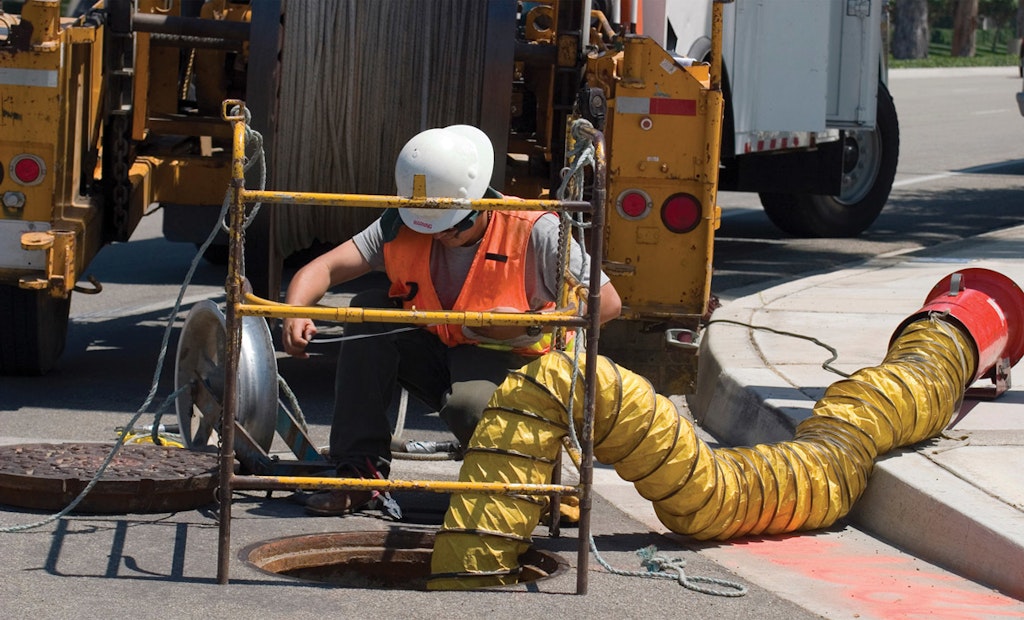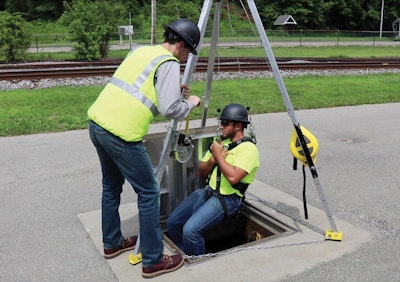
Every crew should have a confined-space rescue plan in case of an emergency, so workers can test the space before entering and quickly leave if it becomes unsafe.
Interested in Safety?
Get Safety articles, news and videos right in your inbox! Sign up now.
Safety + Get AlertsWorking in a confined space exposes workers to risks that can lead to devastating injuries. A confined space is defined as an area unfit for prolonged human occupation, such as a manhole, utility tunnel or basement. These spaces have limited ventilation and few entrances and exits, which makes it difficult for workers to breathe. Hazardous gases can also be present, increasing the risk of asphyxiation or a flash fire.
Every crew should have a confined-space rescue plan in case of an emergency, so workers can test the space before entering and quickly leave if it becomes unsafe.
Testing the space
A lack of oxygen or the presence of toxic, flammable gases aren’t easily noticeable — many of these gases are odorless, tasteless and colorless. You need proper equipment to test for those conditions. A four-gas monitor with a sample pump will draw air from inside the space to test it for hazardous gases, including oxygen, carbon monoxide, hydrogen sulfide and lower explosive limits of combustibles.
Once the team is aware of the potential risks, the crew should try to minimize these hazards as much as possible by bringing fresh air into the confined space. Confined space ventilation equipment pumps clean air into the area while forcing the toxic air out. Some spaces might be better served by exhaust ventilation systems that extract harmful fumes rather than pushing air in. Workers will also need to wear the appropriate protective personal equipment including respirators, arc flash or flame resistant workwear, hard hats or helmets, harnesses and other fall protection for rescue and descent situations, and portable gas monitors in case the air quality changes.
Safely removing workers
Your crew will also need to create a system for quickly retrieving workers from the confined space. This may be if a worker is injured or unconscious, or when hazardous gases are detected. It is absolutely critical that entry by team members outside the space is not required to effect a rescue. A huge percentage of deaths in confined spaces claim would-be rescuers. Don’t let this happen to you.
Time is of the essence and every member of the team should be fully trained on the rescue plan. Attendants, rescue personnel, supervisors and any other employees who might be present on these job sites should undergo training for various situations where they may encounter confined-space hazards or be assisting with someone who might.
During training, focus should be spent on OSHA’s definitions and requirements for permit versus nonpermit confined spaces as well as the criteria for reclassifying a confined space. Training should also involve raising awareness and understanding of common hazards associated with working in confined spaces and how to best protect yourself and coworkers from these related dangers which can include chemical, physical, electrical and/or fire hazards.
Repetition and review
Reviewing roles and responsibilities of certain team members, and what each person needs to do should an emergency occur, can help avoid confusion and panic. While the hope is that an emergency will never occur, identifying the rescue resources and planning around one should not be overlooked.
Checklists that go over PPE items and procedures and protocols that need to be done prior to entering, as well as while working within a confined space, help aid in preparation. Training should be done continuously, to keep everyone on the same page, especially as new workers join the team.
Communication is essential. Since these spaces are restricted, workers can use hardline radios that are intrinsically safe to communicate with those overseeing the job site. Managers and workers who are not in the space should watch out for signs of danger, so they can rescue workers even if they are unconscious.
When entering confined spaces vertically, a rescue and descent system that lowers the worker in and out of the space is needed, paired with a full body harness attached to a winch with a steel cable. Rescue and descent systems usually include a tripod with another overhead system, anchor bolts for securing the tripod around the entry point, like a manhole opening, and the winch for retrieving the worker.
Every job site is different. Tailor your confined-space equipment and rescue plan based on the unique dimensions and characteristics of the space. Workers may need to wear wristlets when the space is too narrow so that the worker can hold onto the handles as they get carried toward the surface before pulling themselves out of the space. Confined-space rescue kits include the important tools that you may need to rescue workers from other narrow work sites — tripod systems, ventilation blowers and ducting, gas monitors and more. These could also include gear designed to protect against chemicals, fire, arc flash or respiratory hazards; communication equipment; and additional fall-protection gear and components. These all-in-one rescue kits are sold for various industries, so be sure to select the one appropriate for your work site.
Every team needs a reliable rescue plan. Use this information to keep your team safe in every situation.






